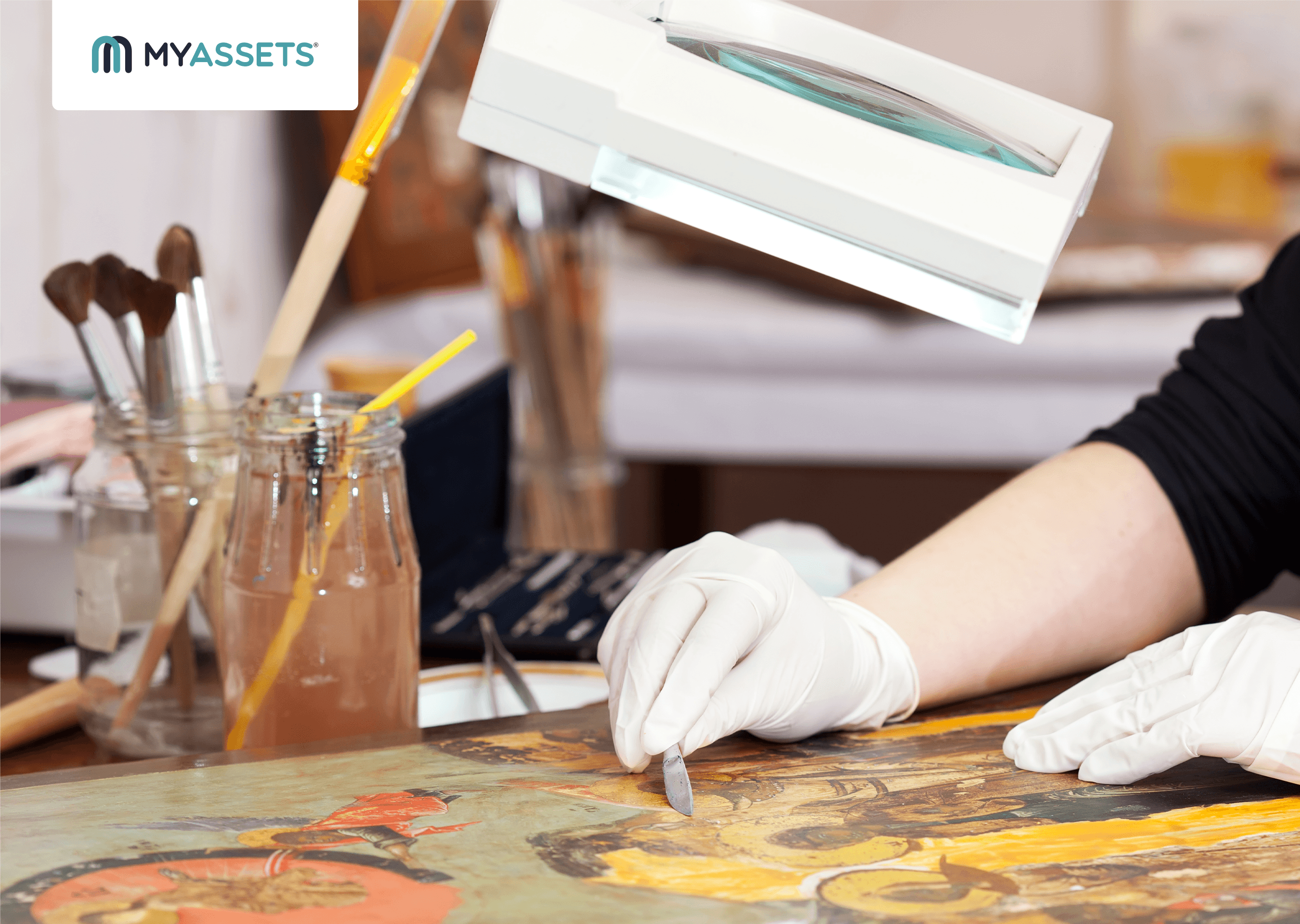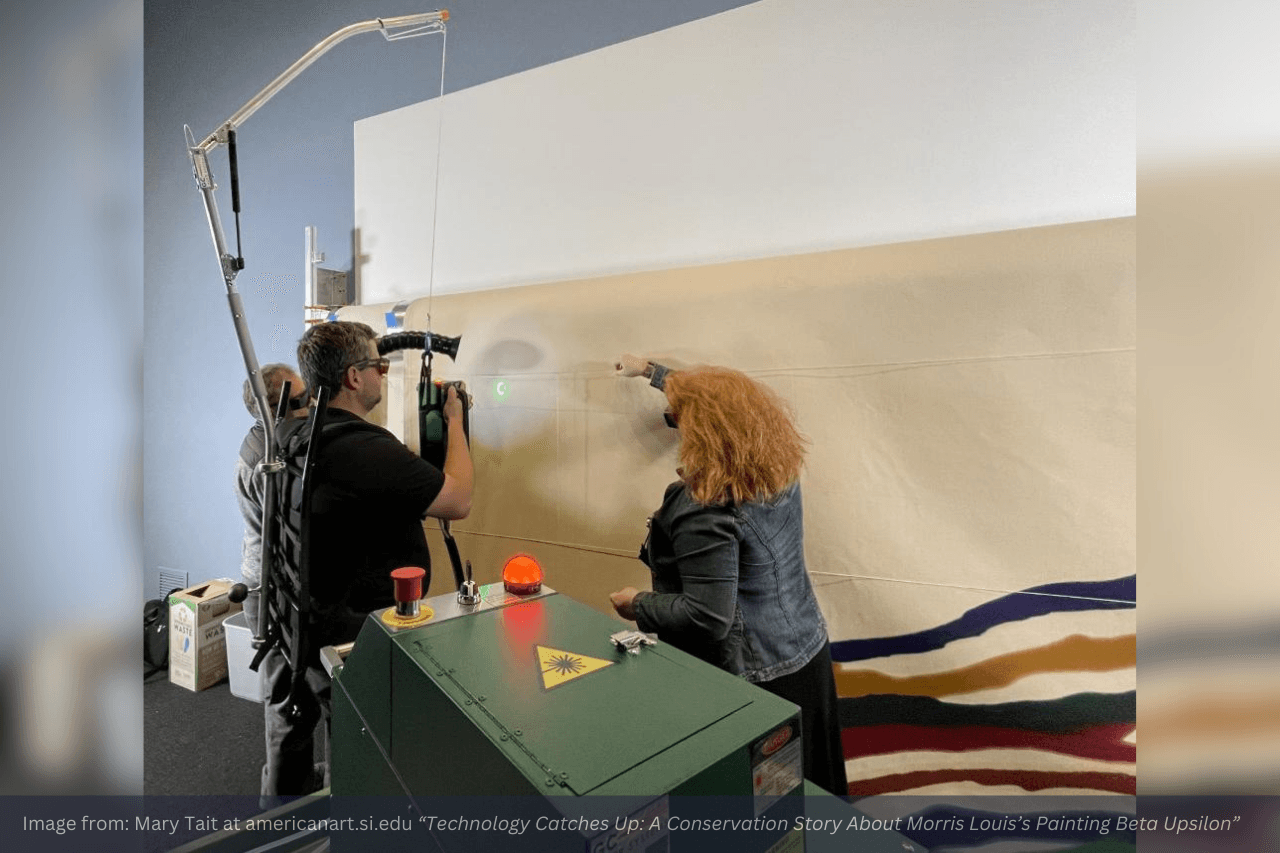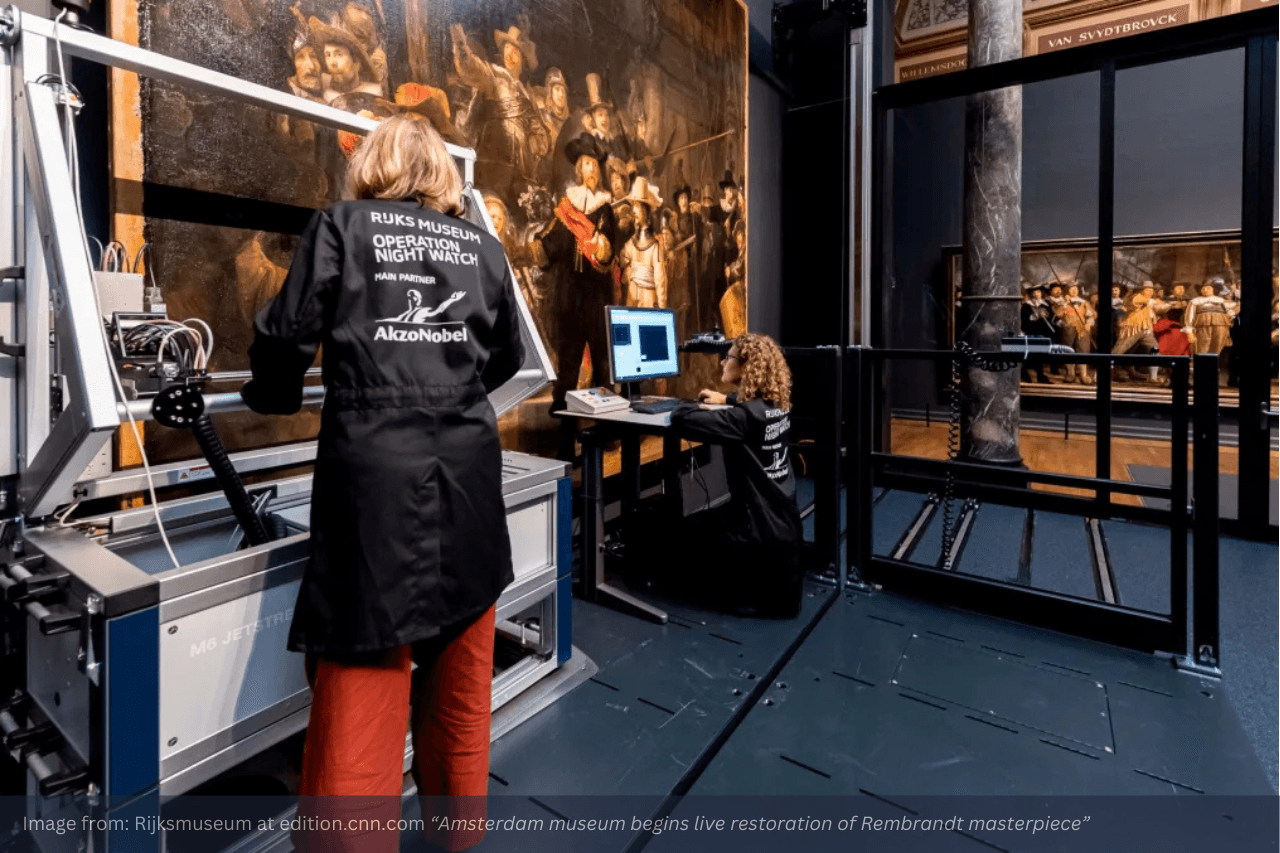Picture a centuries-old painting, its once-vivid colours dulled and its surface worn by time, waiting to be revived. Art conservators are the people behind saving and restoring such treasures. They meticulously uncover hidden layers and restore masterpieces to their former glory.
However, art conservation and restoration go beyond reinstating visible damages. They also involve preserving the essence of each piece, respecting its historical and artistic significance, and remaining true to the artist's original vision.
The Harvard Crimson supports this by highlighting that every artwork is meticulously cared for, with attention given to the artist’s vision and original form. Similarly, The World Art News emphasises that art conservators play a crucial role in bridging eras by preserving artworks to inspire and serve future generations.
The multi-faceted nature of art care conservation has led to the development of case studies that advance the conservation of contemporary art. This article will detail what artwork conservation entails and explore several notable art conservation and restoration cases.
What is Artwork Conservation?
According to a non-profit organisation, Midwest Art Conservation Center, artwork conservation encompasses preservation activities, including examination, documentation, treatment, and preventive conservation – all headed by art conservators.
Artwork Examination
The examination is where conservators apply their expertise in art history and artistic techniques. This evaluation provides insights into the artwork’s identity, creation process, and existing condition issues, which then forms a critical foundation for effective conservation.
Treatment of Artworks
Conservation treatments involve repairing, stabilising, and preserving artworks to ensure longevity and integrity. Conservation techniques aim to be stable and reversible, allowing future adjustments without compromising the artwork.
Preventive Conservation of Art
Art is vulnerable to damage from fire, water, physical forces, incorrect temperature, and other agents of deterioration. Preventive conservation plays a vital role in safeguarding collections—be it proper storage and display, safe handling techniques, or environmental monitoring.
Art Documentation
Art conservation and restoration demands thorough documentation of the artwork's condition, treatments undertaken, and techniques applied. This detailed record enhances transparency and lays the groundwork for future conservation efforts and research.
Fascinating Cases of Artcare Conservation
Dulled by grime and ageing varnish, a centuries-old painting is brought back to life through meticulous care and innovative techniques.
To uncover some of the most remarkable moments in art conservation, this section delves into cases of conserving and restoring masterpieces, highlighting the techniques, challenges, and triumphs that bring new life to these iconic works.
1. Beta Upsilon and the Future of Conservation
Beta Upsilon is a masterpiece by Morris Louis which showcases his signature technique of pouring diluted acrylic paint onto raw canvas. This process creates an interplay of gravity-driven waves of colour that seamlessly blend into the fabric to create a dynamic visual rhythm.
The Seclusion of Beta Upsilon
According to the Smithsonian American Art Museum (SAAM), this monumental painting, which measures over 20 feet, has been hidden from public view for over three decades.
Many have wondered why the piece remained out of sight for so long. The answer lies in the canvas, which bore two graphite streaks—each approximately 31 inches long. A visitor marred the central section of the painting, leaving these unsightly marks, which led to its removal from public display for restoration and conservation.
Revolutionising Artwork Conservation with Technology
When the SAAM painting conservators encountered a defaced artwork in 1989, the available solutions were insufficient to address the challenges of its restoration.
A study by Kerr and Dajnowski identified laser cleaning as a promising solution, although the technology of the time had notable limitations. The light energy emitted by these early lasers was too powerful, making them unsuitable for use on delicate organic materials like unprimed canvas.
However, SAAM Head Conservator Amber Kerr partnered with Bartosz Dajnowski, an object conservator specialising in laser technology, to develop an innovative approach to restoring the artwork.
Their collaboration led to the development of G.C. Laser Systems, a cutting-edge solution that removes materials from textiles without causing damage. The laser utilises isolated green light energy within the spectrum to target and remove graphite marks from Beta Upsilon.
Ultimately, the planning, research, and development of the laser system have driven significant advancements in conservation, enabling the restoration and rediscovery of paintings on untreated canvas.
2. The Night Watch Revival Project
Rembrandt van Rijn’s famed The Night Watch is celebrated as one of the world’s most iconic paintings, asserted by Google Arts & Culture. Breaking new ground in group portraiture, Rembrandt depicted the civic guardsmen in dynamic action, capturing the moment as they prepare to march out.
The Perils of The Night Watch
Over its 377-year history, The Night Watch has endured numerous misfortunes, according to The Art Newspaper.
In 1715, the monumental painting was moved from the Amsterdam militia headquarters to the city’s Town Hall, and its canvas was trimmed to fit a new space. During World War II, the canvas was rolled up and concealed in multiple locations to protect it.
On top of that, it has also faced direct attacks, being slashed with a knife in both 1911 and 1975, and in 1990, an escaped psychiatric patient doused it with acid.
The Museum’s Work on Rembrandt’s Masterpiece
In 2019, the Rijksmuseum began a multi-year study analysing the conditions and techniques used in Rembrandt's famous work The Night Watch. The study was conducted inside a transparent glass chamber within the gallery, allowing visitors to see the process.
The Institute of Conservation reported that the team leveraged advanced imaging and computer technology during the first phase, which concluded in December with an extraordinary find: a concealed sketch beneath the painting that had previously gone undetected.
In 2024, at the Rijksmuseum in Amsterdam, a team of eight conservators began the second phase of Operation Night Watch, which involved removing varnish from the monumental painting.
The restoration is being carried out in a custom-built glass chamber in the museum's Gallery of Honor, which allows the public to observe the process closely.
In a video, the team described how they removed the old varnish using non-woven tissue while saturating it with a precise amount of solvent. This technique minimises physical contact with the painting’s surface, allowing the solvent to dissolve the varnish over about 60 seconds. The remaining residue is removed gently under a microscope with cotton swabs and other methods.
While the painting will appear dull and grey during the restoration, the team assures that applying the new varnish will restore its original vibrancy. This restoration effort follows a series of tests on The Night Watch and other works, all aimed at ensuring the best long-term preservation of the painting.
Overall, the restoration and ongoing research underscore the Rijksmuseum's commitment to preserving this iconic masterpiece while uncovering new insights into its creation. Furthermore, the process offers the public a rare opportunity to witness its transformation firsthand, fostering a connection with its history and significance.
3. The Quest for Survival: Conserving The Last Supper
Leonardo da Vinci began painting The Last Supper in 1495, and over 500 years later, it remains one of history's most iconic artworks.
According to a travel company, Walks of Italy, the masterpiece is rich in symbolism and speculation, from theories about Judas' portrayal to debates over spilt salt and Mary Magdalene’s presence.
However, a more pressing issue has emerged: the need for conservation as the painting deteriorates over time.
The Gradual Decay of a Masterpiece
Leonardo, an innovator, chose not to follow conventional methods when painting The Last Supper, leading to conservation challenges. Unlike the traditional fresco technique of applying wet plaster, which required quick execution and a fixed plan, Leonardo opted for an experimental approach. Lacking experience with large-scale frescoes, he used tempera paint mixed with egg, oils, and other binders, applying it to dry plaster.
This approach allowed him to take more time, completing the work over three years, from 1495 to 1498. However, this risky method backfired, and by 1517, less than two decades after completion, the paint began flaking. By 1582, records indicated that the painting had fallen into "a state of total ruin."
The painting's deterioration wasn’t solely due to Leonardo’s experimental techniques; its location also played a significant role. The painting was exposed to frequent flooding in a damp environment within the Santa Maria church.
Additionally, its proximity to the kitchen meant that it endured constant exposure to steam and smoke from the ovens, further contributing to its decline, as referenced in Business Standard.
Saving The Last Supper: A Conservation Odyssey
According to The Art Newspaper, the first of eight documented restoration attempts on The Last Supper occurred in 1726, when the Dominicans commissioned Michelangelo Bellotti to revive its faded colours. Bellotti used caustic soda to scrub the surface, applied an oil varnish, and heavily repainted large areas of the artwork.
Following Bellotti’s work, three more restorations involved extensive repainting, leading Pietro Marani, co-director of the 1993 restoration, to depict the fresco as an 18th-century recreation. While overpainting has been carefully removed where possible to reveal Leonardo’s original colours, Marani estimates only 50% of the surface is authentically his.
The restoration was challenging due to the gesso layer causing the colours to cluster in concave shapes, requiring meticulous cleaning with magnifying lenses and surgical tools.
Traces of Leonardo’s finishing touches, such as glazing on Matthew’s robes and gold leaf on Judas’s collar, were uncovered. A millefleurs pattern, reminiscent of 15th-century tapestries, was also found on the curtains, and the windows now reveal a luminous, mythical landscape.
While the coffered ceiling no longer exists, evidence beneath the paint on the right side suggests that Leonardo planned a layout with fewer, more widely spaced panels, offering new insights into his perspective.
Additionally, the most significant conservation achievement was the removal of overpainting, which revealed the original faces of Christ and the apostles, obscured since the 18th century.
According to conservator-restorer Dr Pinin Barcilon Brambilla, removing the overpaint from the areas where Leonardo’s original work remains has prevented the risk of condensation forming between the artist's pigment and the later layers of paint. However, she believes The Last Supper will still require ongoing monitoring.
In essence, artwork conservation preserves the integrity of Leonardo’s masterpiece, securing its longevity for future generations to study and admire.
Art for Conservation: Saving the Past, Shaping the Future
Art conservation forges a connection across time, preserving the stories, techniques, and cultural significance embedded within each masterpiece.
The restoration of Beta Upsilon advanced the field of conservation, introducing a laser system that has been beneficial up until today. The meticulous work on The Night Watch emphasised transparency in restoration practices while uncovering new insights into Rembrandt’s process.
Meanwhile, the ongoing care of The Last Supper exemplifies the importance of continuous preservation in maintaining iconic pieces. By safeguarding these treasures, conservation not only honours the legacy of the artists but also ensures their work continues to inspire and educate generations to come.
Artwork Conservation: Frequently Asked Questions
1. What is the role of a painting conservator?
An art conservator is responsible for protecting art for future generations by applying specialised treatments that maintain the physical integrity of artworks, as referenced in Indeed. Additionally, they meticulously record the details of every restoration process undertaken for each piece.
2. What is an example of conservation in art?
The Metropolitan Museum of Art asserts that restoring a painting may include eliminating aged, discoloured varnish, repairing a torn canvas, or stabilising areas of flaking paint.
3. How do you study art conservation?
Studying art conservation involves gaining a blend of scientific knowledge, technical skills, and an understanding of art history. Most art conservators hold a degree, specifically in conservation—such as the BA in Conservation and Cultural Heritage at the University of Lincoln—or in related disciplines like archaeology, museum studies, history, and fine art, according to Prospects.
Effortlessly Document and Preserve Art Conservation Records with MyAssets
Documenting conservation is essential, as it allows art conservators to track restoration efforts, monitor condition changes, and ensure transparency in their work. The MyAssets software revolutionises record management for art conservators and collectors, as it offers a streamlined digital platform to organise, store and access detailed conservation attempts.
Moreover, MyAssets goes beyond documenting art restoration – it offers a dynamic platform for cataloguing and managing treasured collections such as fine art, sculptures, or wall paintings.
MyAssets empowers art collectors to organise, protect, and preserve their assets with ease.
Originally designed as a comprehensive asset management solution, MyAssets allows collectors to store records of restorations, ownership, and provenance – ensuring the collection’s history is documented.
Looking for a secure way to document your conservation efforts? Take the first step in managing your collection with a 14-day free trial.







